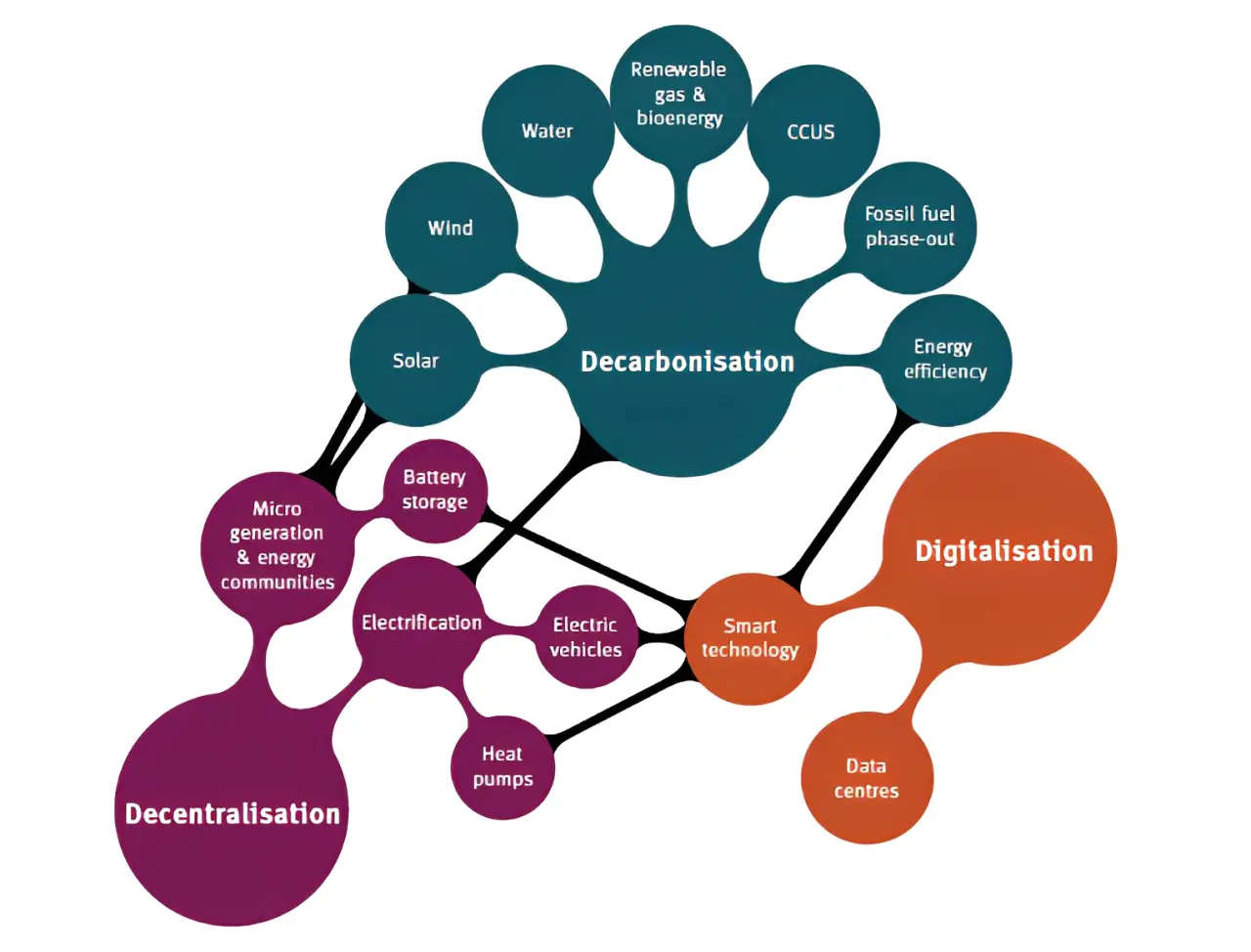Event Schedule | Event Location

Courtesy: WDC Insights
The energy sector worldwide is experiencing a shift influenced by the convergence of decarbonization, digitalization, and decentralization. These three factors are fundamentally altering the methods through which we produce, distribute and utilize energy.
As a result, we are witnessing the emergence of an era characterized by resilient energy systems. This blog post explores the transformations and prospects engendered by decarbonization, digitalization, and decentralization across power infrastructures.
What is Decarbonisation
Decarbonization is the reduction of the number of greenhouse gases released into the atmosphere; the main gas that contributes to this issue to the environment through carbon dioxide. This, however, includes other gases which play a part in the problems, like methane (CH4), nitrous oxide (N2O), and ozone (O3).
Carbonization is mainly related to energy generation and transportation, but it can also be in other businesses from every sector. Decarbonization means embracing other renewable energy sources, like electric vehicles, and installing carbon capture storage equipment.
Why Is Decarbonisation Important to the Power Infrastructure?
Climate Change Mitigation
Reducing greenhouse gas is very vital in the fight against climate change. Decarbonization is the process of decreasing these emissions to combat global warming and protect our planet. Decarbonization ensures it protects the ecosystem and creates a sustainable environment for future generations. We can contribute to reducing the speed of global warming by joining action against CO2 emissions.
Energy Security
Decarbonization contributes to improving energy security by promoting the use of diverse energy sources. Renewable energy technology can help us reduce our dependence on finite fossil fuels. This helps mitigate price fluctuations and reduces geopolitical tensions associated with fossil fuel dependency. Embracing a diversified and resilient energy mix ensures a stable and dependable power supply for the long term.
Public Health Benefits
Decarbonization has a direct positive impact on public health outcomes. We can significantly lower our respiratory illnesses like Lung disease by reducing the air pollution from burning fossil fuels. Improved air quality contributes to better overall health. This enhances the quality of life and helps reduce healthcare costs associated with air pollution-related conditions. We should put our efforts into prioritizing decarbonization to promote a healthy community by increasing the quality of our environment.
Economic Opportunities
Shifting towards clean energy sources creates new industries and job prospects in renewable energy generation and sustainable technologies. This stimulates economic growth by attracting investments and fostering innovation, resulting in a more prosperous and sustainable economy. We can create a win situation by addressing climate change and unlocking the economic potential for a brighter future.
What Is Digitalization, and How Does It Relate to Power Infrastructure
Digitalization is essential in integrating renewable energy sources into electricity systems. This enhances the reliability of power grids and makes electricity more accessible and affordable. It contributes to a fair and equitable transition towards sustainable energy.
We can utilize existing data to optimize the deployment of renewable energy and ensure it reaches the areas that need it most. While the potential benefits of digitalization in the energy sector are widely recognized, it is essential to conduct practical trials and studies to measure the impact of policies aimed at digitalizing energy demand.
These initiatives help identify and address technical and behavioral challenges that may arise while implementing digitalization strategies. Through concrete pilots and comprehensive analysis, we can unlock the full potential of digitalization in advancing a cleaner and more sustainable energy future.
Rapid data, analysis, and connectivity advancements have paved the way for innovative digital applications like smart devices, shared mobility, and monitoring systems. Already, digitalization has improved the safety, productivity, affordability, and resilience of energy systems.
It has also brought about significant changes in markets, businesses, and employment opportunities. However, it is essential to note that energy systems heavily rely on large-scale physical infrastructure and long-term assets, which presents unique challenges in adopting and integrating digital technologies.
Importance of Smarter Digital Infrastructure
Smarter digital infrastructure is essential for several reasons. Let’s take a look at them.
Reduction of Unplanned Power Interruptions
Digitalization allows for the early detection of faults and potential disruptions in the electrical system. With advanced sensors and real-time monitoring, problems can be identified and addressed promptly, reducing the occurrence of unplanned power interruptions. This leads to improved reliability and continuity of electricity supply.
Improved efficiency of power plants and the network
Digitalization enables real-time monitoring and optimization of power generation and distribution processes. This leads to improved efficiency in energy production, transmission, and consumption. By analyzing data and implementing innovative grid technologies, energy losses can be minimized, and power flow can be optimized, resulting in a more efficient overall electrical network.
Comprehensive Datasets and Improved Connectivity
It enables the availability of comprehensive datasets and improved connectivity, allowing for the exchange of vast amounts of information. This abundance of data is crucial as it provides valuable insights and facilitates informed decision-making within the energy sector. Digitalization promotes the use of data analytics, which allows for the extraction of meaningful information from the available datasets. By analyzing this information, energy systems can gain valuable insights into their operations, identify patterns and trends, and make more accurate forecasts.
Data-Driven Decision-Making
Data-driven decision-making becomes possible through digitalization. Using advanced controls and automation, energy systems can optimize their operations based on real-time data, enhancing system efficiency and performance.
Advanced Measurement and Monitoring Systems
Smarter digital infrastructure opens up opportunities in areas such as advanced measurement and monitoring systems, enabling more precise system operation. It also facilitates improved forecasts and predictive maintenance, allowing for proactive maintenance and reducing downtime.
Better Integration of Renewable Energy Sources
Moreover, digitalization offers possibilities on the demand side, allowing for better integration of renewable energy sources, demand response programs, and energy management systems. This empowers consumers to actively participate in the energy market and optimize their energy usage.
Solve Cyber Security Concerns
Addressing cyber security concerns is paramount in the digital era. Smarter digital infrastructure requires robust cybersecurity measures to protect critical energy systems from potential cyber threats and ensure the integrity and reliability of the energy infrastructure.
What Is Decentralization Electrification?
Decentralized electrification involves setting up smaller-scale electricity generation units that cater to specific areas or loads, such as households. These units can be connected to the main electricity grid or operate independently as off-grid systems. These systems can serve various scales, ranging from entire communities like ecovillages to individual buildings like condominiums or small villages. Decentralized electrification gets powered by either diesel generators or renewable energy sources like solar power and wind, among others. The most common decentralized energy systems are;
- Heat and power (CPC)
- Waste-to-energy plants
- Biomass combustion
- Solar power
- Geothermal energy.
Why Is Decentralization Electrification Important to Power Infrastructure?
Reduced Technical Losses in Distribution Lines.
Lengthy distribution lines significantly contribute to transmission losses in the electrical grid. When electricity is generated and travels through these lines, electrons collide.
These collisions create electrical resistance, leading to the production of heat. Unfortunately, this heat is lost and wasted without efficient harvesting and storage methods. Decentralized energy management systems solve this problem by bringing the electricity supply closer to the demand.
This proximity reduces the transmission losses and associated costs in a centralized system. Grid operators and energy suppliers can benefit significantly from this decentralized approach, as it helps minimize unnecessary expenses and improve overall efficiency.
Rural and Remote Electrification
The distance between large power plants and remote rural areas presents challenges in transmitting electricity in terms of distance and funding. To address this issue, decentralizing energy management can be a viable solution.
By establishing local power plants near these underserved rural communities, independent smart grid operators and energy suppliers can provide easier access to electricity. Implementing smart grid systems in smaller communities facilitates efficient and cost-effective power distribution due to their proximity.
This approach helps bridge the gap and ensure reliable electricity supply to remote areas.
Lower Capital Costs Per Project
Establishing centralized power plants requires significant financial investments, including the costly expansion of the power grid and an imbalance in the cost-to-consumer ratio.
One challenge energy suppliers face in centralized systems is monitoring power consumption in remote areas and the associated difficulties in billing. However, decentralizing energy management allows for a more customized power supply that matches the specific needs of consumers.
This results in grid operators and energy suppliers avoiding financial losses caused by excessive electricity supply compared to minimal demand.
Quality Services Resulting
Centralized energy management systems often result in a monopoly of energy supply services. This monopoly leaves consumers with limited options and little control over the quality of service they receive.
To address this issue, it is important to decentralize energy management systems. Decentralization allows for the presence of multiple energy suppliers and smart grid operators who can establish their infrastructure in proximity to the end-users they serve.
With increased supply and competition, energy suppliers are incentivized to enhance the quality of their services, benefiting consumers with improved energy solutions.
Planning Flexibilities
Decentralized energy management systems offer significant advantages for grid operators and energy suppliers. Unlike the centralized system, which has rigid modes of transmission and limited flexibility, decentralized systems allow for more effective decision-making without the complexities of a centralized structure.
These systems enable communities of consumers to access power from diverse sources, reducing reliance on a single grid.
This enhances reliability and promotes a sense of community among energy players. Alternative power sources can be tapped into in a grid failure, minimizing the impact on individual power plants.
The interconnected networks of decentralized systems create a more resilient and efficient energy infrastructure, benefiting operators and consumers.
Efficient Use of Combined Heat and Power Systems
In centralized energy management systems, the heat generated during electricity production is often wasted or goes unused, causing harm to the environment. However, decentralized energy management systems offer a solution by capturing and utilizing this heat for various purposes, such as heating and cooling homes and industries.
By effectively utilizing waste heat, Combined Heat and Power (CHP) plants can achieve up to 80% more efficiency than gas power stations, which are less environmentally friendly and have lower efficiency levels ranging from 49% to 52%. Decentralized energy management systems are locally focused, meaning they are not necessarily limited to rural areas but operate on a smaller, more localized scale.
Technical Relationship Between Energy Retailers and Consumers
These systems enable improved communication between grid operators and prosumers through advanced metering systems. Prosumers, who both produce and consume energy, can now sell excess power to the grid if they are connected to it or store it for future use if they are not.
Integrating smart metering and IoT technology allows for seamless monitoring of electrical situations at prosumers’ locations, making data collection and analysis easier for energy suppliers. This closer relationship between energy suppliers and prosumers within shorter distances helps reduce costs associated with energy losses, theft, and transmission failures.
Overall, decentralized energy management systems provide greater efficiency and sustainability in energy consumption and distribution.
Conclusion
Ultimately the combined impacts of decarbonization, digitalization, and decentralization are reshaping power infrastructures and molding the trajectory of the energy sector. The gradual transition towards cleaner renewable energy sources reduces our dependence on fossil fuels. Actively combating the effects of climate change. Integrating digital technologies enables smarter and more efficient energy systems, optimizing generation, distribution, and consumption. Furthermore, decentralizing energy generation and distribution empowers individuals and communities, fostering energy independence and resilience. These transformative trends are propelling us towards a dependable and inclusive energy future. By embracing these changes, we can cultivate a conscious world and secure a promising future for generations.



